by Winding Pathways | Nov 19, 2020 | (Sub)Urban Homesteading, Reflections/Profiles
Guest Bloggers Share Their Memories of Past Autumns
We invited readers to share their fall traditions and memories with Winding Pathways to help us through the 2020 Autumn and Holiday/Holy Days season.
Flowers For Fall
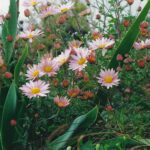
Chrysanthemums bring joy.
JH- “Every year I tend lovingly to a patch of chrysanthemums that I planted many moons ago in my vegetable garden. It has a place of importance along with my four lilies in this particular raised bed. This plant sprouts in spring and gradually makes
its way skyward until the September coolness brings teeny tiny buds which become a single petaled soft orange sherbert color. I always leave the seed stalks during the winter because I know that birds love the seeds. A sense of peace and joy washes over me as this patch sallies forth in the fall. The bees and butterflies love it as well.
Soon the cold of winter will send it into its deep sleep to wait for another year of gorgeous blossoms.”
Family Gatherings

Extended family
SF- “Many T-givings we spent at Grammy’s. Everyone sat around the table, Gram at one end, Grandpa at the other. Gram served up the potatoes and veggies, she then passed the plates along down the line to Grampa who put the meat on then it was passed down the other side. Each of us, uncles and aunts, got our meals. Gram always loaded our plates which was always too much for us kids. One year Gram said something to us that she was tired of us not eating all our food and she was tired of throwing away good food. Mum stood up and told her we served ourselves at home and we’re expected to eat what we were given. At subsequent T-givings Gram would ask us how much we wanted and then ate what she gave us. After Grammy passed away usually Aunt Bunny and Uncle Joe came for T-giving at our house on Tibbetts Hill. Uncle Joe was always fun.” Editor’s note: The family later hosted extended family Thanksgivings at their New Hampshire homestead.
***
Loving the Amanas

Special time with Pops.
KT – “I miss going to the Amana’s with my father. He has passed and while he hated the changing of the seasons to cold weather, he loved eating and visiting the Amanas with his grandchildren. We always started with breakfast at the Colony Inn. For the best thin pancakes and sorghum, along with fresh fried potatoes, eggs, and English muffin toast with homemade strawberry jam. Then we had to head to the General Store for candy purchases usually Swedish fish, Rock Candy, and Red Licorice. If we had visitors with us we would tour the Woolen Mills and the Furniture Store and of course the Christmas Store with the most beautiful decorations.
“The Amanas is the closest thing we have to a fun Oktoberfest setting and environment. Such a great little historic village with many family memories for me!” Editor’s note: The girls are grown now. One lives in Nashville and the other attends Luther College.
Day Trips

The Mississippi River stretches from Minnesota to the Gulf Coast.
S&MN – “Each fall, we would invite a couple of language teaching assistants, recently arrived in Minnesota from France to a ride down the Mississippi River to view the changing colors of the leaves. Conversation on the ride to Wisconsin gave us a chance to learn more about each of them and their first impressions of their stay in the US. We would follow the Mississippi River down the Wisconsin side to Stockholm, Wisconsin, where we would lunch at a small cafe, visit the Amish quilt shop, gift shops, and antique stores. This included touring a small museum of the original post office.
Conversation Openers
We would stop at the scenic Maiden Rock overlook and Lake Pepin. Did you know that Water Skis were invented there? We’d take in the Laura Ingalls Wilder Museum in Pepin, Wisconsin, and visit the replica of the Little House in the Big Woods. We shared stories and explained about the Little House book and movie series as we could. We loved making connections to life in France during the same time period of the 1870s and learning which facts were most interesting to the young interns who had read the book series in France. Thirty years ago, the language assistants would have been fans of the TV series by the same name La Petite Maison Sur La Prairie. It was a popular series on television in France. In recent years, the students would have been given details learned on the show by their mothers who had loved the show as children.
Conversations on the way back to the Twin Cities would be filled with questions that were often spurred by what we saw and that most usually unanswered. These conversations provided us with opportunities for conversation topics in the months that followed as many were inspired to read the series in English during their stay after the visit.”
Saint Paul Intercultural Institute
***
New Adventures for a New Englander
SH – “The first autumn after we moved to Wisconsin from New Hampshire I had a wonderful introduction to the fall bird and waterfowl migration. I had never experienced anything like it.
Horicon Marsh is huge! Part of it is federal lands and part is state lands. I was not sure what to expect when it was suggested that we join my husband’s parents for a Sunday outing. I was totally amazed and awed at the sheer numbers of birds that were flying, landing, and swimming in the water. A busy main state highway that runs across the top area of the marsh. Lots and lots of cars were parked on the edges of the road with families, watching out for traffic. People were wandering about taking in the sights.
When our daughters were young, we made sure that they also had the opportunity to see this mighty spectacle. I still enjoy going across that state highway and exploring the area. A recent addition is a park-like area with a paved one-way auto road with pull-outs and informational signage. Trails to hike and a boardwalk that has a gazebo with scopes get visitors out into the marsh for better viewing. There are also various dykes and dirt roads to boat landings to explore. After the autumn rush of migration, it is still a fun place to visit, and so far no matter when we visit, I have never been disappointed. It seems like we are always able to find some wildlife and sometimes get great photos of birds we don’t see on a regular basis.”
Paranormal
SBF – “When I bought a house in FL her son told me that the lady who had lived there before had loved her house and property very much. After I moved in with my friend, Jinx, on several nights I awoke to the TV sounds in the family room so I would go turn it off. This went on for 3-4 nights. Finally, on the fifth night I turned it off once more, but I stood by it and spoke to the previous owner. I told her I loved the house and lovely plants around it, a ginger bush, a beautiful poinsettia bush, and a pretty plant on the backyard fence. Then I promised I would try to care for them as best as I could. “But please,” I asked, “could you not turn on the TV after we go to bed at night as I had to get up to go to work 5 days a week.”
The TV never went on at night after that!”
Thanks for sharing autumn stories!
by Winding Pathways | May 3, 2020 | Birds, Nature
Can you introduce kids to bird watching and get “outside” during novel coronavirus times?
We read a short article written by a diehard baseball fan. She had bought season tickets to her beloved St. Louis Cardinals just before the pandemic hit. When the virus shut down baseball she said, “I’m not watching the Cardinals but I am loving the cardinals……the ones that sing in my backyard.”
Like the baseball fan, many people are enjoying birds in their yards and neighborhoods – often for the first time. Birding is an outstanding hobby and this spring is an outstanding time to start. Being confined to the house and yard is a great opportunity to introduce kids to birds. Also, usually, the best birding of the year is in early May when avian migrants move through and visitors from the far south nest nearby.
Birding requires no license. There isn’t a closed season. Enjoying birds is free and can be done everywhere, even in the biggest cities. It’s a hobby that can be started simply and may evolve into a lifelong passion.
Basic Homebound Birding with Kids
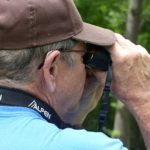
Bird watching is again a joy with hearing aids.
Cost: nothing.
Special equipment needed: None, but a pencil and a few sheets of scrap paper can help record observations.
Encourage kids to watch birds in the yard. Most can identify cardinals, blue jays, and house sparrows but distinguishing species for a beginner isn’t essential. Just have kids note how one type of bird looks and acts differently than others. Essentially how a cardinal differs from a sparrow. Maybe have the kids sketch the birds they see.
The Next Step
Cost: Around $125 for entry-level binoculars and a basic bird book.
Equipment: Binoculars and a bird book and bird apps:
At this stage begin identifying and recording species seen. Read with a child descriptions of the life history, migration patterns, and habitat of different species.
List all the birds seen in the yard. This is the start of a “life list”.
A Little More Advanced
Cost: Not much. The basic equipment listed above works but add in a few dollars for gas to visit nearby habitats.
After a child can distinguish between backyard bird species and has used a bird book or app it’s time to search for more species. Bring along binoculars and a pad and pencil. Visit nearby wetlands, woodlands, and grasslands. Even with novel coronavirus shutdowns, most places allow people to visit parks and natural areas. Each will feature new bird species. Take note of them and read about each. Add new species to the list started with backyard birds.
Igniting a Passion
Most children are curious about nature and seeing just one or two fascinating birds can ignite a lifelong passion that may become a delightful hobby or even a professional career. Advanced birders purchase sophisticated optics and travel the world to see new species and learn more about these fascinating animals. Hopefully, the novel coronavirus will pass soon and the world opens to a youngster with a new birding hobby. It all can start by spotting a blue jay in the backyard.
Where to Get Information
At Winding Pathways, we have many paper bird books produced by several companies. We don’t favor one over the other but often refer to several when we’re trying to identify a bird new to us. Increasingly we rely on the Merlin App created by the Cornell Laboratory of Ornithology. The descriptions of hundreds of bird species, along with photos and calls, is at the tip of our fingers on our iPhones. It’s free. Simply go to the App Store and search for Merlin. The Lab of Ornithology has many other fascinating resources that can be accessed from a computer or smartphone, and we love their paper magazine Living Bird.
The National Audubon Society is highly bird-oriented and has local chapters. Attending a meeting or going on a birding excursion with members is an outstanding way to connect with people who share a bird passion. Some chapters may offer ZOOM meetings. Others hold online excursions to help people get and stay connected. Earth Day saw a host of events online.
We also enjoy reading Bird Watcher’s Digest, a small format magazine that features articles about individual species and places to enjoy them in every issue. The Internet is loaded with many other bird resources.
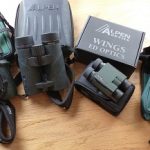
Alpen optics are good quality with good value.
We are often asked what type of binoculars we use. None of our optics is high end. Rich prefers 8X42 power while Marion’s are 10X42. The first number is the magnification and the second indicates how much light enters the optic. Eight or 10 powered binoculars that give a clear view and fit well in someone’s hands are ideal for a budding birder. Tiny micro binoculars are great for travel but we find them much harder to use than larger ones.
Spring is the best time to see migrating birds, and the novel coronavirus is confining people to yards. It’s an opportunity to take notice of the colorful and interesting wildlife that comes to us. This is a wonderful time for a child to launch a birding hobby.
by Winding Pathways | Jun 7, 2018 | (Sub)Urban Homesteading, Birds, Garden/Yard, Nature
Birding in our Back Yard
We’ve traveled throughout the United States seeking interesting birds, and we just discovered the very best place.
It’s our backyard! Since we began actively diversifying the plants in our yard they’ve welcomed many new bird species to visit, rest, and eat. And, we live next to Faulke’s Heritage Woods, a 110 acres of shrubs and old trees that is a warbler and woodpecker haven.
Anyone who plants an array of bushes and grasses in their yard, even if it’s a tiny yard, can enjoy birding at home. Planting appropriate shrubs, mainly native species is important because some shrubs like barberry are invasive and crowd out beneficial plants.
Because the yard is right out the door, it is an easy place to grab the binoculars and a glass of wine or cup of tea and sit quietly.
Here’s what we’ve seen or heard in our yard in the past two weeks:
The winter birds left quietly – juncos and siskins. And, on their heels arrived the migrants.
Resident and Migratory Birds
Warblers: Black-Throated Green, Tennessee, Blackpoll, Cerulean, Yellow, Yellow-Rumped, and Redstart
Woodpeckers: Pileated, Hairy, Downy, Red Bellied, Red Headed, and Flicker. Earlier in the year, we saw the telltale evidence of the elusive sapsucker – wells drilled horizontally in sap filled trees.
Others: Bluebird, Cowbird, White Crowned and White Throated Sparrow, Chipping Sparrow, House Sparrow, Starling, Turkey, Crows, Vulture, Cooper’s Hawk, Barred and Horned Owls, Eagles, Chickadee, Nuthatch, Brown Creeper, House Wren, Titmouse, Goldfinch, House Finch, Robin, Wild Turkey, Hummingbird, Oriole, Rose-breasted Grosbeak, Indigo Bunting and a Wood Duck winging overhead. Additionally, Canada geese and pelicans have flown over on their way to ponds and lakes.
Recently Rich and a friend hiked to Hanging Rock in Effigy Mounds National Monument in northeast Iowa. They birded on the seven-mile walk. It was outstanding and spotted many species. But, not as many as we’ve seen sitting in our own backyard!
Winding Pathways encourages people to diversify the plants in their yards to create truly wondrous places that birds love. It can be the best place in the world to enjoy them.
-
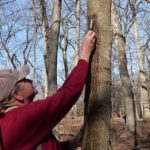
-
Rich points to horizontal holes of sapsucker.
-
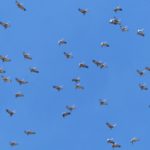
-
Winging Overhead.
-
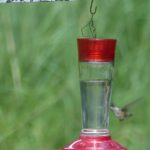
-
Getting nectar.
-
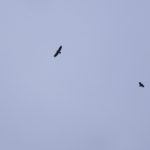
-
Two eagles in sky
-
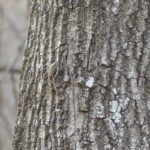
-
A camouflaged creeper on tree trunk.
-
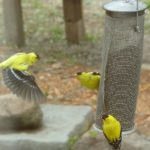
-
Iowa’s state bird
-
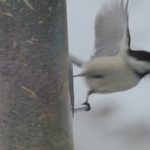
-
The cheerful denizens of open woods.
-
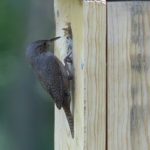
-
Checking out a birdhouse
-
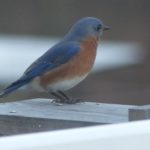
-
Male bluebird.
-
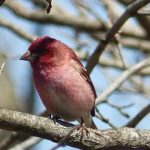
-
On a branch
by Winding Pathways | Nov 16, 2017 | Travel/Columns
TRAVELING WITH BINOCULARS
Disclosure: Years ago we were asked to serve on the Alpen Optics Birding Pro-Staff and periodically we receive optics to test. Following is a report on using mini-binoculars while traveling.
In October we enjoyed a 1600-mile, 12-day clockwise loop around Washington State. After picking up our rental car at the Spokane airport our journey took us through deserts, mountain passes, the Olympic rainforest, and even across Puget Sound on a ferry.
We enjoyed spotting new bird species, sea lions, jellyfish, Roosevelt elk, and a host of other wildlife. Good thing we brought along binoculars! We wouldn’t dream of traveling without binoculars and use them constantly. Even when we trek to New York City we tote along a pair. But, for this trip, they presented a dilemma.
We wanted to avoid checking baggage on the plane to save cost and the possibility of a lost suitcase.

Rich with compact binoculars.
Delta Airlines limited us to a small suitcase that we could carry on the plane. Squeezing nearly two weeks’ worth of clothes and supplies into these packs was a challenge. It became obvious that we couldn’t fit in our full-size binocs. Mini Binoculars to the rescue! Our Alpen Wings ED compact binoculars easily nested into a hiking boot that we tucked in the pack.
For all around general binocular use, and when we’re traveling by car, we always use full-size binoculars. They fit our hands well, provide a bright image, even at dawn and dusk, and their field of view is wide. Their downside is bulkiness.
Many optical companies sell high-quality compact binoculars. Go for quality. Inexpensive models are nearly useless. Here are the pros and cons of mini binoculars:
PRO
Compact binoculars are handy because they are small. They easily fit in a glove compartment, purse, or jacket pocket and take little space in a suitcase. Mini’s are ideal for travel. Quality ones have clear optics.
Having a pair of mini binoculars handy is always better than not having binoculars.
CON
Mini binoculars have a limited field of view and are rarely as good in low light situations as their full-size cousins. We find them a little harder to use and hold than full-size models and would never choose to use minis for long viewing sessions or if we went on specific birding excursions. But they are invaluable when size and weight are limited.
The best solution is to have two pairs of binoculars. One full sized model for general use and minis for travel and convenience.
by Winding Pathways | May 10, 2017 | Birds, Flowers/Grasses, Nature, Travel/Columns
May is about the most exciting month to travel and camp out in Iowa. We took in the Driftless area of Iowa and Wisconsin where we learned more about mounds at Effigy Mounds National Monument, ate at funky Café McGregor, took in Starks and Cabelas in Prairie du Chien, and entered our favorite forest over the “Forest Road” into Yellow River State Forest.
- Note our reviews and thoughts are independent, unpaid and unsolicited.
Enjoy this photo journal of our stay.
-
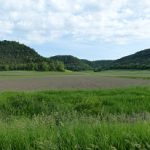
-
Fascinating terrain and vegetation characterize the Driftless Area.
-

-
More questions than answers arise when investigating mounds.
-

-
Looking Down River
-
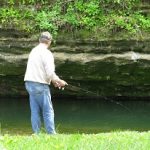
-
A great fishing spot.
-
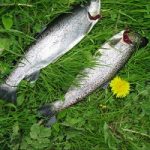
-
Fresh fish for dinner.
-
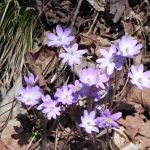
-
Spring is about a week later in northeast Iowa than central Iowa.
-

-
Nettles were a resource for Native Americans and still are for modern day foragers.
-
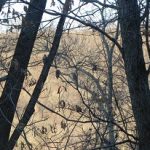
-
Last year’s young hang around as long as they can.
-

-
A favorite walk.
-

-
Season Five now open!
-
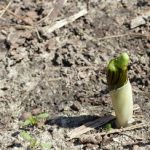
-
Tightly wrapped Mayapple pushes through the early spring ground.
-
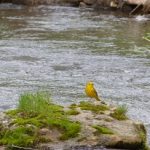
-
Birding is exceptional in May.





























